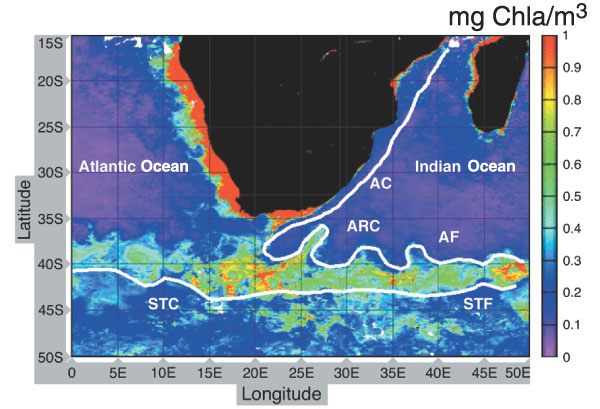Agulhas Return Current on:
[Wikipedia]
[Google]
[Amazon]
 The Agulhas Return Current (ARC) is an
The Agulhas Return Current (ARC) is an
 The Agulhas Return Current (ARC) is an
The Agulhas Return Current (ARC) is an ocean current
An ocean current is a continuous, directed movement of sea water generated by a number of forces acting upon the water, including wind, the Coriolis effect, breaking waves, cabbeling, and temperature and salinity differences. Depth conto ...
in the South Indian Ocean
The Indian Ocean is the third-largest of the world's five oceanic divisions, covering or ~19.8% of the water on Earth's surface. It is bounded by Asia to the north, Africa to the west and Australia to the east. To the south it is bounded by ...
. The ARC contributes to the water exchange between oceans by forming a link between the South Atlantic Current and the South Indian Ocean Current. It can reach velocities of up to and is therefore popular among participants in trans-oceanic sailing races.
Oceanography
The ARC originates from theAgulhas Current
The Agulhas Current () is the western boundary current of the southwest Indian Ocean. It flows south along the east coast of Africa from 27°S to 40°S. It is narrow, swift and strong. It is suggested that it is the largest western boundary curren ...
, the western boundary current
Boundary currents are ocean currents with dynamics determined by the presence of a coastline, and fall into two distinct categories: western boundary currents and eastern boundary currents.
Eastern boundary currents
Eastern boundary currents are ...
of the Indian Ocean, at the Agulhas Retroflection Agulhas (''needles'' in the Portuguese language — or ) may refer to:
* Cape Agulhas, the southernmost point of Africa
* L'Agulhas, a town near the Cape
* Cape Agulhas Lighthouse, located at the Cape
* Cape Agulhas Local Municipality, the municipa ...
south of Africa and flows east along the Subtropical Front, roughly around 39°S, north of the Antarctic Circumpolar Current
The Antarctic Circumpolar Current (ACC) is an ocean current that flows clockwise (as seen from the South Pole) from west to east around Antarctica. An alternative name for the ACC is the West Wind Drift. The ACC is the dominant circulation feat ...
.
The Agulhas Current follows the continental shelf of the African east-coast, pass through the Agulhas Passage
The Agulhas Passage is an abyssal channel located south of South Africa between the Agulhas Bank and Agulhas Plateau. About wide, it connects the Natal Valley and Transkei Basin in the north to the Agulhas Basin in the south and is the only n ...
until it leaves the Agulhas Bank
The Agulhas Bank (, from Portuguese for Cape Agulhas, ''Cabo das Agulhas'', "Cape of Needles") is a broad, shallow part of the southern African continental shelf which extends up to south of Cape Agulhas before falling steeply to the abyssal p ...
and reaches the Agulhas Basin south of South Africa. From there it retroflects almost completely back into the south Indian Ocean as the ARC, and only a smaller part, known as Agulhas leakage, is shed into the South Atlantic
The Atlantic Ocean is the second-largest of the world's five oceans, with an area of about . It covers approximately 20% of Earth's surface and about 29% of its water surface area. It is known to separate the "Old World" of Africa, Europe a ...
.
The water mass loses a lot of heat at the Agulhas Retroflection, up to , while evaporation and precipitation change the composition of the upper layers. The ARC, therefore, has another composition than the Agulhas Current proper. It also loses velocity from and volume transport from 70 to 54 million m³/s. Furthermore, all traces of Indian Tropical Surface Water are gone.
Having left the retroflection, the ARC meanders east between 36°S and 41°S.
These meanders were described as Rossby wave
Rossby waves, also known as planetary waves, are a type of inertial wave naturally occurring in rotating fluids. They were first identified by Sweden-born American meteorologist Carl-Gustaf Arvid Rossby. They are observed in the atmospheres an ...
s in 1970 and are known to shed cold eddies
In fluid dynamics, an eddy is the swirling of a fluid and the reverse current created when the fluid is in a turbulent flow regime. The moving fluid creates a space devoid of downstream-flowing fluid on the downstream side of the object. Fluid ...
equatorward and enhance the primary productivity
In ecology, primary production is the synthesis of organic compounds from atmospheric or aqueous carbon dioxide. It principally occurs through the process of photosynthesis, which uses light as its source of energy, but it also occurs through c ...
at the Subtropical Front.
The ARC makes a large, quasi-permanent northward meander around the Agulhas Plateau after which it loses more velocity and volume by leakage into the South Indian subtropical gyre. Over the Crozet Basin the last remnants of the ARC are gone.
As it enters the Crozet Basin at 53°E, the transport of the ARC is 35 Sv, most of which is recirculated northward before reaching the Kerguelen
The Kerguelen Islands ( or ; in French commonly ' but officially ', ), also known as the Desolation Islands (' in French), are a group of islands in the sub-Antarctic constituting one of the two exposed parts of the Kerguelen Plateau, a large ...
-Amsterdam
Amsterdam ( , , , lit. ''The Dam on the River Amstel'') is the capital and most populous city of the Netherlands, with The Hague being the seat of government. It has a population of 907,976 within the city proper, 1,558,755 in the urban ar ...
Passage.
The current east of the Crozet Basin, at 66°E-70°E, is called the South Indian Ocean Current and lacks the distinctive features of the ARC.
References
Notes
Sources
* * * * * * {{Refend Currents of the Indian Ocean